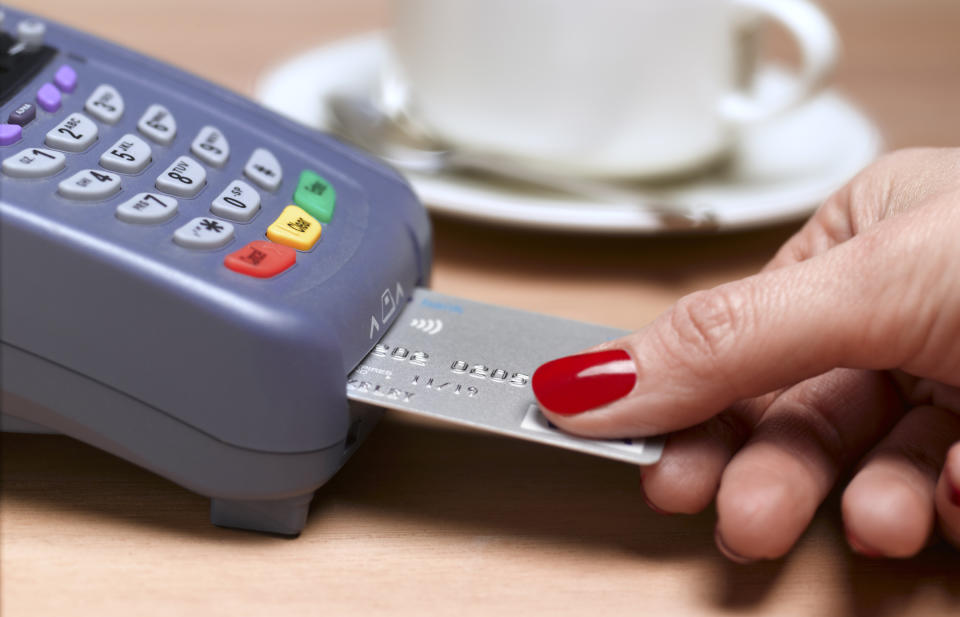No more PINs: Visa testing biometric credit cards

People are just getting used to chip credit cards, but a new technology is already on the horizon.
Earlier this month, Visa (V) announced that it’s testing on-card biometrics for contactless payments at two different banks —Mountain America Credit Union in West Jordan, Utah, and The Bank of Cyprus.
Biometric technology uses physical characteristics to authenticate a person’s identity. In the case of Visa’s pilot, cardholders will use fingerprint recognition instead of PINs or signatures for authentication.
Visa’s biometric card is programmed with a securely stored template of your fingerprint. When the card is used, customers will be asked to hold their fingerprint against a small sensor on the card while inserting the chip into the cardreader or waving it for contactless payment. That fingerprint is then compared to the one stored in the card to verify the user’s identity. Green and red lights are integrated into the card to indicate a good or bad match.
“The world is quickly moving toward a future that will be free of passwords, as consumers realize how biometric technologies can make their lives easier,” said Jack Forestell, head of global merchant solutions for Visa.
Adding biometric features to credit cards is seen as a way to simplify card usage and also make it more secure. As the art of card skimming has evolved, magnetic strips are no longer able to thwart criminals looking to steal your money. By the end of 2017, most banks had issued new chip cards equipped with EMV technology. These chip cards are more secure and harder to hack, but still require a PIN which can be accessed by hackers.
Using biometrics could feasibly help with all of these issues.
Biometric data is unique to each individual, making it harder for criminals to use a stolen card. Using a fingerprint is more secure than entering a PIN or signature, and these cards use EMV technology, so they’ll be immediately compatible with existing payment terminals.
While Visa’s biometric credit cards are just being piloted, the company has already unveiled the use of biometrics with other services. Cardholders enrolled in Apple Pay can make contactless payments simply by using their fingerprints. This approves the payment without swiping the card, entering a PIN, or providing a signature.
The future of payments
Visa is just the latest issuer to test out biometrics and credit cards. In April 2017, Mastercard tested its own biometric credit card in Johannesburg, South Africa. The trial took place at a bank and supermarket, and allowed cardholders to use fingerprints for authentication.
Chaya Hendrick is the CEO of Smart Metric, a technology engineering company that develops biometric software for credit cards. She says that PIN technology is more than 30 years old, and that consumers are ready for a better option.
“Phones have already demonstrated the acceptability of biometrics for security, and consumers readily accept that biometrics are safer than passwords,” said Hendrick. “The market wants a better and more secure credit card.”
One thing that may hinder the popularity of these cards is the cost associated with having one. According to Hendrick, biometric credit cards contain a small circuit board as thin as a piece of tissue paper, a component that costs way more than an existing chip card. “At this point in time you’re not looking at a giveaway product,” she told Yahoo Finance.
This means that customers who chose to use the biometric credit card will likely have to pay for it. Hendrick speculates that this could be as high as a one-time fee of $69.95. A Visa spokesperson said they expect cards will cost significantly less upon commercial launch, especially once broadly available for consumers.
That fee, however, may be one that Americans are willing to pay. After the Equifax breach, more and more consumers are worried about fraud and looking for other ways to protect their identity. Perhaps that’s why a recent study commissioned by Visa found that 86% of consumers are interested in using biometrics to make payments.
In the meantime, Visa says that it has plans to expand their biometric technology to more partners in the future.
Brittany is a reporter at Yahoo Finance. Follow her on Twitter.
Chase Sapphire Reserve cutting 100k sign-up bonus in half
Is Chase Sapphire Reserve the best travel credit card ever?
Here’s how Amex Platinum’s new perks compare to Chase Sapphire Reserve

 Yahoo Finance
Yahoo Finance 
